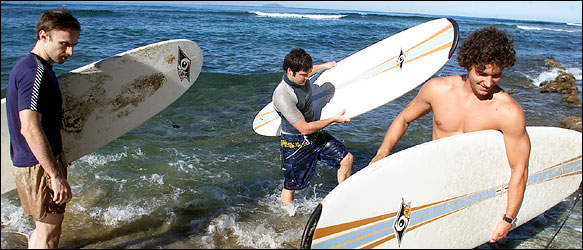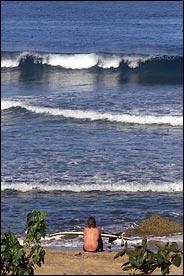|
 |
|
Esta página no está disponible en español. THE NEW YORK TIMES In Puerto Rico, Discovering A Surf Mecca By JULIA CHAPLIN January 30, 2004 PHOTOS: Ricardo Figuero for The New York Times
ENDLESS SUMMER Peter Zabowski, a surfing instructor, right, with students at Rincón, P.R. ON a warm afternoon in mid-January, the sunset happy hour was revving up at the Calypso, a wooden open-air bar perched on the side of a hill overlooking Maria's, the main surf break in Rincón, P.R. Throngs of buff surfers in sandy flip-flops, board shorts and T-shirts were sipping $2 Coronas and exaggerating their day's surf triumphs when, suddenly, all heads turned to watch the action about to unfold in the water. A massive wave was building on the orange-pink horizon. About a dozen surfers were paddling fiercely toward the peak. As it broke, two tanned guys on short boards, pushed out ahead and caught the glassy, barrel-shaped eight-foot wave. They were carving beautifully across the face when they suddenly smashed smack into each other. Boards shot up and tangled in the crashing white water in what was — judging by the gasps it elicited from the crowd at the Calypso — an amazing double wipe out. "Aw, Man!" yelled a surfer pounding his fist on the bar. "That was gnarly!" Just another idyllic day in Rincón, a small fishing village on the western-most tip of Puerto Rico, with chickens wandering in the streets and rich thickets of bougainvillea framing the narrow roads, that in the last couple of years has become the destination of choice for surfers from the Northeast looking for a quick, largely bother-free escape from muddy snowdrifts and bone-chilling temperatures. To hang 10 in Rincón's 70-plus-degree swell, one need only shell out about $300 to hop a four-hour nonstop flight from Newark to Aguadilla, and then drive 30 minutes south. (It's almost as easy as going to Miami, and there are no pretentious fashion police awaiting you.) And you do not have to be a hard-core surfer to join the line up. Rincón is on a point jutting into the Atlantic Ocean, so there are dozens of surf breaks that wrap around the town in varying size, shape and force. If one break is a little too challenging, chances are there is a more mellow one around the corner. Most of the surfers congregate at Maria's (reminiscent of a scene out of "Gidget," if only Sandra Dee had worn a string bikini and Moondoogie had longer hair and tattoos) and Domes (the site of Latin America's first nuclear energy plant, which has been defunct since the 1970's). To the north of the point is Parking Lot and Sandy Beach, which is near Tamboo, a palm-shaded restaurant that is a good spot to keep "Beach Bettys" and "Beach Bobs" occupied. If such nonsurfers are in your group, they may like the south side of town, where the water is pond flat, clear and great for swimming and snorkeling. Unlike some other tropical surf capitals — like Puerto Escondido, Mexico; Tamarindo in Costa Rica; or the Caribbean islands of Tortola and Barbados — Rincón's surf infrastructure is so well oiled that it's quite possible to achieve surf nirvana in a long weekend. Cellphones have reception, the roads are well paved, and most surf shops and guesthouses rent boards (for about $15 a day) and offer surfing lessons (prices vary from $20 an hour to $89 for the day). Note to aspiring female surfers: the instructors tend to be young and attractive, which makes having sun block rubbed onto your back and shoulders much more enjoyable.
Surfers have been flocking to Rincón, since the World Surf Contest was held there in 1968. East Coast surf bums who didn't want to make the trek all the way to Hawaii or couldn't afford it showed up with tents, sleeping bags, surfboards and little else. Many never left and now run guesthouses and restaurants, like the Calypso, which explains the surfer-friendly policies. Most restaurants and bars don't require shirts or shoes; the Calypso even installed a nonslip floor for the safety of dripping surfers. It's easy to feel the pull. Cheerful, brightly painted concrete homes dot the green foothills of La Cadena mountains, salsa and Puerto Rican rap wafts from car radios, and friendly shopkeepers often address you by the Spanish version of your first name after just two days. "There's something about sitting by the fountain on the town square and eating empanadas after surfing all day that's really magical," said Sam George, editor of Surfer magazine. Many tourists who plan to come for a quick weekend jaunt end up extending their trip for days, weeks or in some cases years. (Continental must make a killing from those $100 ticket-change fees.) Betsy Wadsworth, 34, an M.B.A. from Manhattan, came to Rincón seven months ago for a few days to give surfing a try. (Her best friend had found information about the town on the Internet.) Ms. Wadsworth checked into the Rincón Surf & Board guesthouse and signed up for surf school. After a few lessons she was hooked. In September, she returned, bought a house near the beach and started her new life as a full-time surfer. "I started getting better and better," Ms. Wadsworth recalled on a recent afternoon as she checked out the waves at Parking Lot. "Suddenly all I wanted to do was surf." Now she spends her days in board shorts and a bikini top, surfing from dawn till dusk with packs of surfers from places as disparate as New Jersey and Australia. Ms. Wadsworth had tried surfing in Maui but chose Rincón because she liked the people and it was convenient for her husband, a restaurant consultant who is still based in New York, to visit her. "I have a warm, fuzzy feeling about the place," Ms. Wadsworth said. "There's no other way to explain it." Many of the surfers stay at the numerous budget guesthouses like the Rincón Surf & Board. Situated in the hills of Barrio Puntas, the three-story rambling wooden house has a pool, a tiki bar and a breathtaking view of the ocean. Surfers pile into co-ed dormitory rooms with bunks. Valuables are kept in wooden cubbyholes with padlocks, and clothes are strewn in piles on the floor. Each bunk comes with a surfboard rack mounted on the wall beside it. There are also private rooms. A real surfer's paradise has to have cheap food. And in Rincón, it's possible to eat on just a few dollars a day. (Beware: surfers tend to rate fare based on price and quantity, not quality.) For breakfast or lunch the spot is Puntas del Mar, a bakery and general store that sells café con leche and carbohydrate-laden pastries, sandwiches and empanadas. (Everything on the menu is under $3.) For dinner, old surfboards mark many of the popular restaurants like the Rock Bottom, which serves burritos and tacos, and the Calypso, which has fish burritos ($7) and rice and beans ($3.50). If you feel like splurging, Rincón has its share of upscale restaurants too: the Landing (Caribbean classics), the Spot at Black Eagle (fresh seafood) and the Blue Room (the formal dining room at the Horned Dorset Primavera hotel, which serves French Caribbean food). On a recent afternoon John Ellis, 23, who graduated from Columbia University last May, was lounging in a hammock on the porch of the Rincón Surf & Board reading "The Iliad" between surf sessions. "The climate is perfect and there are good vibes," said Mr. Ellis, who had come to Rincón just after New Year and is chilling out a few months before joining the Navy in April. "You have to be seriously antisocial not to make friends here." One night at Tamboo, the open-air bar that overlooks a surf break reminiscent of a set from "Survivor," groups of tanned surfers stood around drinking beer and watching surf videos. Dave Chapman, 20, a college student from Brigantine, N.J., who had come down to Rincón for four days with his older brother to relax before the next semester, surveyed the room. "It's cheap, there are no mosquitoes, and you can surf all day long," he said, yawning. He had waked at 7 that morning to surf, and his flight was leaving early the next day. "There could be a few more girls here," Mr. Chapman said. "But besides that, what more can a guy ask for in a long weekend?"
|

 __________
__________ __________
__________